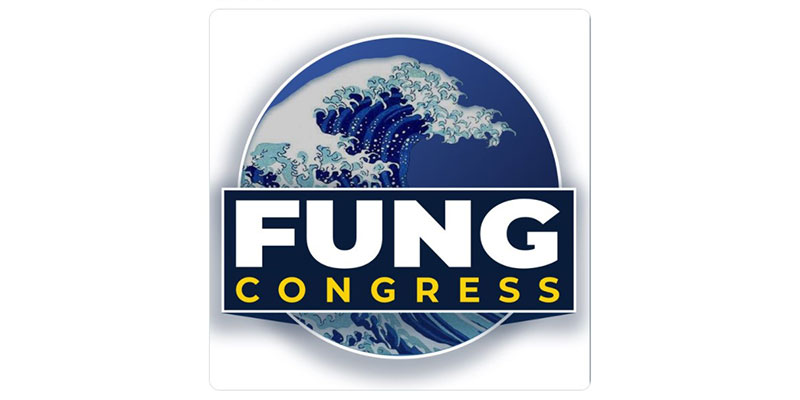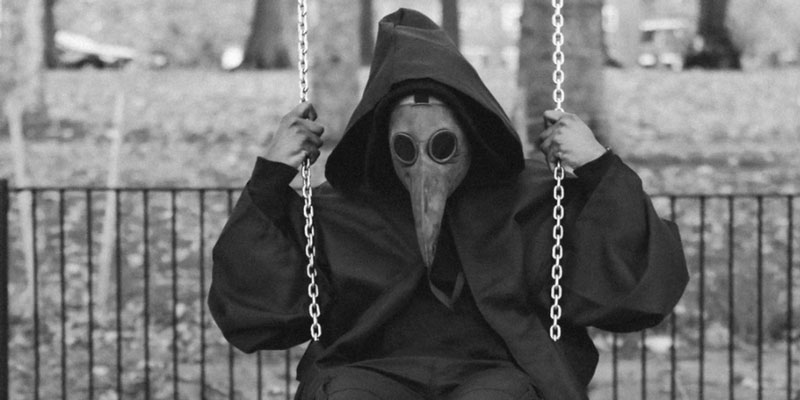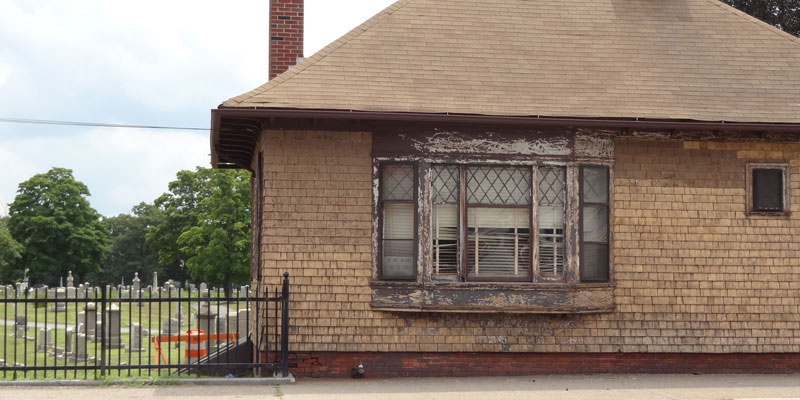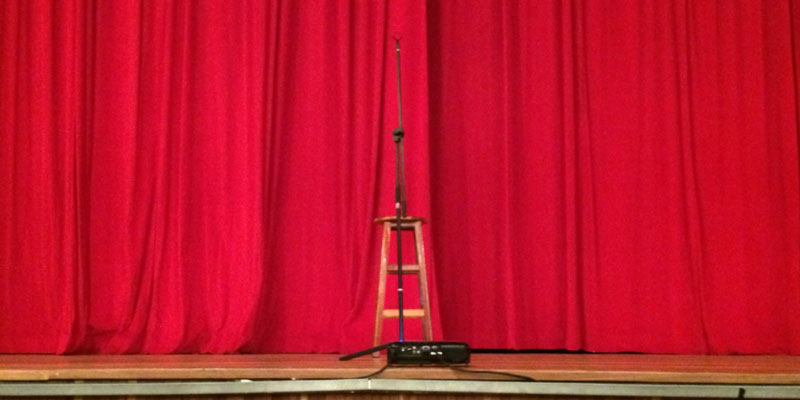John talks with Christopher Leonard, author of The Lords of Easy Money, General Reginald Centraccio, on military affairs in RI, and Tony Lemonde, of Senior’s Choice RI.
Featured image by Jp Valery on Unsplash.
[Open full post]The headline of this post is genuinely meant. I’m entirely withholding judgement and am mainly curious what now-candidate Fung is planning.
You may have heard that Allan Fung has entered the race for Rhode Island’s second district seat in Congress with this tweet:
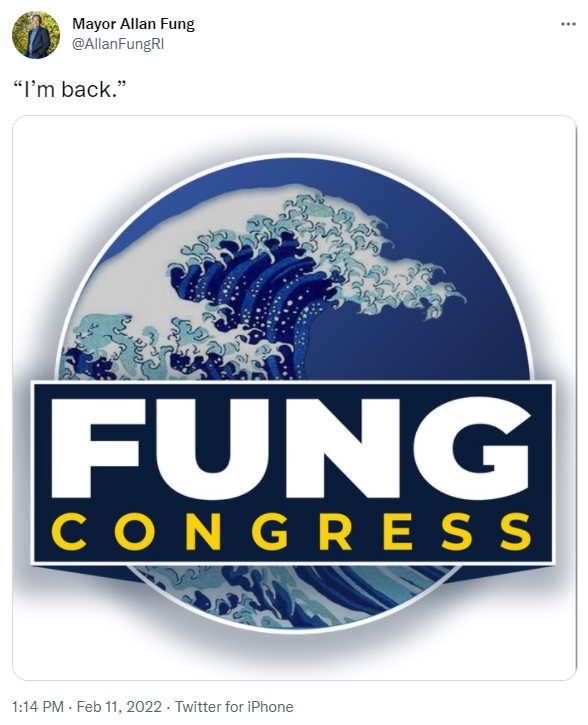
It’s a great logo that will look cool on t-shirts and other promotional items, with subtext indicating some thought. The image is from arguably the most iconic work of oriental art in history (albeit Japanese, whereas Fung is of Chinese ancestry), giving a slight heritage-inspired twist to the theme of the Ocean State while invoking the notion that he could be part of the Republican wave that analysts generally expect in November.
Conspicuously, Fung’s wife, state representative Barabara Ann Fenton-Fung (R, Cranston) was in the news just yesterday promoting her legislation to require Asian-American history to be taught in all Rhode Island schools. Her bill has its own intriguing political complications. Beyond the peculiarity of a Republican promoting identity politics, conservatives won’t miss the emphasis she puts on “the horrible things that happened in [American] history,” like the true, divisive progressive that she has proven to be. One might also note that Fenton-Fung has no similar bill touting the achievements of her own lineage, Irish Americans, who could make their own claims about “horrible things” in American history.
Meanwhile, the Fungs are building this Asian-candidate theme even as a controversial Olympics is being held in Communist China, during the winding down of a disruptive pandemic for which many Americans, especially within Fung’s political party, blame those same communists — whose curious relationship with the Democrat President may very well be an issue during the election.
Again, I’m not insinuating a conclusion here. What makes this fascinating is that Fung’s deliberate political positioning is a bit like choosing to throw your kayak in the river right in the midst of rapids. I have no idea how this plays out.
[Open full post]Matt Margolis has some fresh details:
[Open full post]Rep. Troy Nehls (R-Texas) revealed on Tuesday that in November, Capitol Police entered his office without his knowledge or consent, photographed confidential legislative documents, and later returned dressed as construction workers and questioned a member of his staff.
I have to chuckle when I see a progressive like Steve Ahlquist pen an article with a headline like, “A corrupt process from the core, Rhode Island redistricting wraps up.”
I mean, a corrupt redistricting process is about as surprising as a hangover after a long night of drinking without water breaks, and progressives are all about that big government bender. Notice the number of words Steve spends faulting Republicans for not pushing back on Democrats enough, even as he’s silent about anything at all his progressive Democrat allies might have done.
Why is this so difficult to understand? Three things — and only three things — will limit corruption in government. One, reduce its power to the point that moral incentives have a chance against corrupt incentives. Two, tolerate a split political system in which the powerful know their opponents may soon wield the power they assert right now. And three, foster countervailing powers in society with their own incentives to keep government in check.
Progressives oppose all three, because their guiding light is a world in which they have the power to do everything as they believe it should be done. That is also why we can be sure they’d be just as corrupt (or worse) if they ever take control.
[Open full post]COVID-19 can be a nasty disease, even when it’s not a killer, which it most definitely can be. The coronavirus is not, however, the only killer, and disease is not the only nasty thing that can happen to your life.
As we look out across the landscape of continuing fear, ramped up to an irrational level, and observe, aghast, the willingness of many of our neighbors to throw away our rights liberally in exchange for the promise that somebody else will take responsibility for our well-being, we should give due consideration to Eli Sherman’s article on WPRI, “2021 was one of the deadliest years on record in Rhode Island.”
If the news story has any practical utility, it can only be to assess the decisions of those who claimed such extraordinary power when the pandemic arrived in our state and, thereby, to foster accountability and readjustment. Yet, the question of whether the response was justified or well managed is not even asked. The implied answer is, “of course!”
Wherever that angle might come up, Sherman gives the government’s public health architects the floor:
“While preliminary data suggest that our overall fatalities for 2021 were lower than our total for 2020, COVID-19 still tragically took the lives of more than 1,000 Rhode Islanders last year,” interim health director Dr. James McDonald told Target 12.
That statement simply isn’t true. If we wish to be generous, perhaps we could say only that it is not precise, but the 1,157 deaths that the state puts on the board for COVID were people who died with the disease, not from it. We do not know what the overlap truly is, and we will never know how much this loose definition covered up deaths that would best be attributed to the government’s response to the disease.
WPRI leads with a chart that shows nothing in history like 2020’s 1,542-death spike in Rhode Island since the 2,897-death spike resulting from the 1918 flu — before we had even penicillin to fight diseases. Tracing that line, readers might reasonably wonder whether the lockdowns had any justification at all, given that the Spanish Flu was so much more deadly than the Chinese Communist Flu.
The answer is not open-and-shut in either direction. Supporters of the regime might next turn to Sherman’s chart of historical death rates, which show the COVID spike in a much less dramatic light. This takes into account, most notably, the larger population, and here lockdown advocates might insist we can see the benefit of their policy. Fair enough; but this picture doesn’t justify Sherman’s scary headline about “the deadliest years on record.” He tries to have it both ways.
Those of us who argue that the lockdowns were too destructive might also notice that Sherman is incorrect to assert that “the death toll from drug overdoses… has grown each year since 2018.” His own chart shows that overdoses were down in 2019, as part of a downward trend every year since 2016. The year of the COVID lockdowns, 2020, brought a 25% leap, with an additional 76 deaths.
Tragically, 2021 brought another increase, albeit a smaller one. So, if we return to Sherman’s scary headline, the context is quite different. Comparing 2021 to 2019, we see an increase of 835 deaths from all causes. Eighty-eight of those (11%) were from overdoses. If suicides followed a similar trend, they’d account for another 4% of the overall increase. Homicides were also up about 20% in 2020 (although that trend began the year before, perhaps for policy reasons). Now factor in deaths because people skipped hospital visits, were more sedentary, were more anxious, and so on, and the idea that the response to COVID played a significant role becomes plausible, indeed.
For the sake of our rights and our health, these are topics that require thorough public scrutiny. Unfortunately, the news media seems disinclined to help in that effort.
Featured image by Daniel Adesina on Unsplash.
[Open full post]Judy Schwalbach makes that connection explicit in a report on school choice policies and history in Washington, D.C.:
During the 20th century, federally sanctioned housing “redlining” influenced the composition of neighborhoods in large cities across the country, including Washington, D.C. The term “redlining” came from the color-coded maps developed by the Home Owners Loan Corporation (HOLC) (on which mortgage lending under the Federal Housing Administration (FHA) was partly based). The HOLC limited access to federally backed mortgages for home loans in the red-colored and lowest-grade neighborhoods described as “hazardous.”
Although Congress outlawed discriminatory lending policies in the mid-20th century, prior government practices had created geographic concentrations of lower-income families. Coupled with residential assignment of schooling, which is largely maintained by school districts today, many schools remain racially and economically segregated. Unlike many other metropolitan cities throughout the United States, however, Washington, D.C., has effectively overcome the barriers imposed by geographic school boundaries through open enrollment, a robust charter school sector, and a private school scholarship program. States should follow this lead, and, at the same time, take steps to prohibit school districts from drawing attendance zone boundaries within their borders.
When one hears about the history of redlining policies, lately, it’s usually in the service of a “systemic racism” argument. Basically, overt racism in the past segregated black Americans and deprived them of the twentieth century’s opportunities for the collection of generationally accumulative wealth.
Well, one of the most profound consequences of that development can be found in where and with whom a community’s children are educated. Eliminating that barrier — that marker of segregation — ought to be a no-brainer for advocates who truly wish for the betterment of minority families. Whether they take the opportunity to seek out private schools or stay under the public-sector umbrella, the pathway out of failing schools, which they’ll walk with other children who will acculturate them to the practices and expectations of families that were not subjected to that historical racism, will broaden, even as it forces the schools they are leaving to improve and better demonstrate their value.
The advocates, themselves, may not have thought through the reasons that their suite of policies have collected together, but in this case, strong candidates step forward as explanations. The Democrat Party is defined by its preference for a big-government, centralized-decision-making approach, which necessitates resistance to proposals that distribute resources and authority. Sharpening this bias in education, in particular, is the huge reliance on teachers unions for political donations and activism, which builds a defensive wall against accountability in public schools. Furthermore, long cultivation of identity politics and a grievance industry has made key figures at the intersection of minority communities and the Democrat Party completely reliant on continuing strife between the races.
Advocates who specifically focus on housing have even more reason to break from these partisan chains. After all, if a house in a low-income neighborhood nonetheless provides access to high-quality schools anywhere in the state, in or out of the government school system, its value will increase. Thus, even as the children’s prospect for earning generational wealth increase, their parents’ property will grow in value — probably more rapidly than the market overall, because beginning from a suppressed baseline.
Featured image by Justin Katz.
[Open full post]Don’t get me wrong. RI House Minority Leader Blake Filippi is right to be pursuing his lawsuit against the Joint Committee of Legislative Services, which is undoubtedly a central hub of our legislature’s corruption. But the judiciary isn’t where these disputes should have to be resolved. Think about it:
Filippi, the top Republican in the R.I. House of Representatives, filed an initial complaint against his fellow legislative leaders nearly two years ago, alleging he’d been unlawfully excluded from meetings of the powerful Joint Committee of Legislative Services.
Two years. Think how thoroughly that sort of timeline stacks the deck in favor of corruption.
The problem is that our political system is pretty thoroughly locked up for the benefit of a single party, so our political system cannot foster accountability. If power could conceivably change hands from election to election, those controlling the JCLS, one, wouldn’t be as comfortable creating such a powerful entity, because it could be handed over to their opponents in the next election, and two, would be compelled to back off when this sort of controversy arose, because they’d be afraid that not doing so would have political consequences.
[Open full post]I suspect they’re wildly overrepresented in the items that Twitter pushes onto my screen, but Rhode Island progressives are really something to behold in their reaction to Democrat Governor Dan McKee’s belated and overly hesitant removal of statewide mask mandates.
As I suggested earlier, for many of the recognizable personalities, their rhetoric is probably wholly political and ideological. They’ve got a primary to win, so whenever possible, they have to paint everything the more-moderate incumbent does as wildly wrong and dangerous. (To younger generations, this style of politics is relatively new, largely amplified by social media, and it’s making it impossible for anybody actually to govern reasonably.)
Still, they’d get no traction and back off if they didn’t think their primary voters were susceptible to their fear mongering.
Turn now to a series of tweets in which conservative Canadian media figure Ezra Levant predicts how “this trucker rebellion is going to end.” I’m not sure about Levant’s conclusion, but the series is worth sorting through for a related reason. Number 9 is the paragraph that really brought it home. Here’s the text:
That video [of police arresting a tiny old man] is bad enough. But imagine going truck by truck, extracting men, women and children? Here’s a vid from the Coutts border crossing. What’s Trudeau going to do — shoot them? Policing doesn’t work when the bulk of citizens don’t consent.
The video is the key part, though. It’s not of truckers, but of what looks to be hundreds of people blocking a road by riding horses down it! The next video is of a bridge that carries 25% of U.S.-Canadian trade completely filled with stationary trucks.
Did you know this was happening? It’s pretty likely that you did, oh Anchor Rising reader, but do you know because you get your information from mainstream, much less progressive, sources? Do you think the progressives’ core audience knows the extent of it? Probably not.
You can bet, though, that the people in public office making high-stakes political decisions are discussing it. You can also bet that they’re terrified that Canada’s rebellion will light the combustible tinder of American politics. Distractions like making Joe Rogan bend the knee might forestall things for a few news cycles, but then, they might whipsaw, combine with the trucker story, and add fuel to the fire.
They know this. And so, they have to begin letting some of pressure out of the fuel tank before it explodes, and easing ridiculous, performative mask mandates as COVID cases evaporate is an easy way to do that.
The lesson of the bubble is an important one to catch, though. The ruling party and its allies in the mainstream media control people’s understanding of reality so as to make their preferred policies more palatable, but when narrative control is central, rather than tangential — when public relations becomes the core function of government rather than a poorly lit office down the hall — natural incentives will lead to fiction stretching across an unacceptable reality. As that reality builds on itself, the fiction becomes a bubble.
People who haven’t been given an accurate picture of current events can’t factor everything into their subconscious calculations. If the trucker rebellion over the northern border can be written off as a temporary lashing out by ignorant people like your anti-mask-mandate neighbors in the Ocean State (as local progressives see us), then mask mandates might make sense (if you believe they have a positive effect).
If, however, we’re on the verge of a collapse of the North American economy that is likely to throw state and federal governments firmly in the hands of the MAGA people, progressives will only be clutching their mask mandates as they sink to the bottom of the political sea, having lost everything.
The dangerous part is when they realize that they are about to lose everything. The progressives are more likely to call for government violence and fixing elections than to acknowledge error. The question is how ideologically intoxicated the Democrat Party in the Ocean State has become.
Featured image by Mick DePaola on Unsplash.
[Open full post]Recently, Rhode Island Twitter has become a display of people who seem deranged with fear about the end of mask mandates. It’s a curious puzzle.
Some of the known progressives are probably responding to the movement’s understanding that keeping people depressed and isolated is in their ideological and political interests, and that surely filters out into the general public, like contagious radiation. Naturally, however, the progressives in the public health bureaucracy are happy to lend some propaganda to the push.
Doug Badger gives a careful look to the study behind a widely shared chart from the CDC making masking look extremely effective:
The made-for-Twitter visual mischaracterizes the findings of the Feb. 4 study. That study was so poorly designed that the confidence intervals—the range of possible results, similar to the “+/-” in public opinion polls—were large enough to render its findings meaningless.
Of course, the anti-mandate side has folks who are willing to overstate their own case, and it can be difficult to know what the truth is. Taking it all in, I continue to think the reality is that masks can be effective for some people in some circumstances but cause more harm than good as a blanket mandate, especially in schools. The fact that schools look likely to be the last place unmasked shows that we’re not dealing with science, but with a mix of politics and fear.
[Open full post]Bob Walsh, who has been the executive director of the National Education Association of Rhode Island as long as many of us have been paying attention, or even been present in the state, has announced his impending retirement.
Some on the conservative side are understandably happy to hear the news, but I’d caution a bit of circumspection for two reasons.
The first is that his replacement could be much worse. My impression may be wrong, but Walsh has always seemed to me to be enough of a political junky, who enjoys actual debate enough, that he stays closer to the line of fair play than is the case for many of his coworkers and close allies. In some ways, that may make him more effective, but it certainly allows opportunity for those who disagree with him.
The second is that he’s probably not going away. The letter that he sent to his union’s members explains his decision as giving him “time for another adventure or two.” Maybe that means trying his hand at mixed martial arts, or maybe it means applying his vast connections and practical knowledge to an even more extreme charge in his far-left activism… while opening up the highly paid slot in the far-left progressive movement in Rhode Island that he’s held for decades.
Maybe his departure will work out for truth, civil liberties, and the good of Rhode Island, but it’s far from certain.
Featured image by Tiago Donangelo Figueira on Unsplash.
[Open full post]

